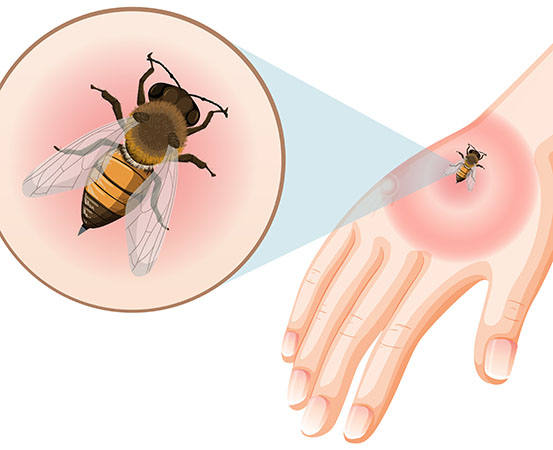
In May 2022, Arvind J (28) was in a temple atop a hillock in South Bengaluru to attend a family function when he was suddenly attacked by a swarm of bees. In an unfortunate incident, several guests who attended the event faced the same fate.
“A joyous family gathering turned into a nightmare. 18 people who attended the event were stung by bees. All of us had to be rushed to a nearby nursing home where we were treated with medication to reduce inflammation. Some of my cousins managed to run far away from the event venue but were still chased by the bees,” Arvind tells Happiest Health.
Explaining the reason for the bee attack, Arvind says, “There were beehives on the roof of a neighbouring high-rise building. The smoke from the puja fire (havan)- made of herbs and leaves- from the temple reached this spot and disturbed the bees.” Immediately after getting stung, Arvind experienced itching, swelling and redness on his neck, hands and head, where he got stung.
READ MORE :
Frostbite: the cold hard facts
How to manage a jellyfish sting
What to do when a scorpion stings
Be it a dog bite or scratch, anti-rabies vaccination is essential
“When the beehives get disturbed, due to smoke or other factors, the bees get agitated, and this is when they tend to sting. Bees sting only when agitated and there is no particular season in which they tend to sting more,” says Dr T M Manjunath, agricultural entomologist and a former professor at the University of Agricultural Sciences, Bengaluru.
Symptoms of a bee sting
In more than 80% of all cases, people who have been stung by a bee don’t require medical assistance. The symptoms of the sting can easily be controlled by administering local anaesthetic and analgesic for pain and inflammation, say doctors. But the formic acid in the bee sting causes allergic reactions.
Dr Dilip Gude, senior consultant physician, Yashoda Hospitals, Hyderabad says that bee stings can produce a spectrum of clinical conditions – on the harmless side, it can cause slight pain and itching while in extreme cases, you may end up in the Intensive Care Unit (ICU).
“In extreme cases, your bronchial tubes close up, making it difficult for you to breathe. Another extreme case is a condition known as angioedema. Here, the laryngeal area goes into a muscle spasm, making it very difficult for one to breathe. This is a clear-cut medical emergency that can also turn fatal with time,” he adds.
Dr Gude says people who are hyperallergic or have a higher propensity for conditions like asthma may react worse than others for bee stings. If one develops any breathlessness, lightheadedness, wheezing or any pain or itching in the affected area, it is time to seek medical help, he cautions.
In some people, the symptoms can worsen four to five hours after the sting. Hence, monitoring for 24 hours is important, say doctors.
Wheezing after bee sting hints complications
A 32-year-old-man visited the emergency department of a Hyderabad hospital recently, complaining of pain and slight breathlessness after being stung on his arm by a bee. He was non-diabetic, non-hypertensive and had no comorbidities but had severe pain in the affected site.
With a stethoscope, the doctors heard a ‘wheeze’ sound, which sounded like a whistle coming from the man’s throat. “This was a clear sign that an impending complication was coming,” says Dr Gude. “Luckily, he lived close to the hospital, and was brought in immediately, in less than one hour. We first removed the bee’s stinger and administered epinephrine or adrenaline (used to treat severe allergic reactions). We also prescribed hydrocortisone and corticosteroid (steroids to treat the inflammation),” says Dr Gude.
What to do immediately after a bee sting?
Dr Girish Narayanan, professor, department of emergency medicine, St John’s Medical College, Bengaluru says, “First, identify the site where you got stung and see if the stinger is still present. Remove it if you can. If you can’t, leave it alone. We also advise people to hold the affected area under running water if possible to wash it off.”
Dr Gude says that in 70 to 80% of cases, the stinger is easily visible and can be easily removed which is ideal, he says.
“After a bee sting, there are chances of the insect venom penetrating into the skin long after the stinger is broken. Hence, it is ideal to remove the stinger, if possible,” he says.
The American Academy of Dermatology Association (AADA) recommends avoiding using a tweezer to remove the stinger since this can lead to more venom spreading into the skin. Use a fingernail or a piece of gauze instead.
The AADA adds that after a bee sting, one must stay calm. “Walk away from the site calmly,” the association states.
Takeaways
- Stay calm after a bee sting, remove the stinger if possible and wash the area with soap and water.
- In case of bee stings, if you develop any breathlessness, lightheadedness, wheezing or any pain or itching in the affected area or if you have been stung multiple times, seek medical help.
















6 Responses
There are various ways which i knows,But get to know now
Put ice cubes on the sting site. It reduces pain and swelling as well.
Very handy write-up for the follow-up action against a bee sting, especially for those who suffer from comorbidities like asthma, diabetes and so on.
Thank you for your positive response!
Very informative. Generally, people panic after being attacked by bees. Your advice to deal with bee attacks is very helpful to people. Thank you very much.????
Thank you for your positive feedback!